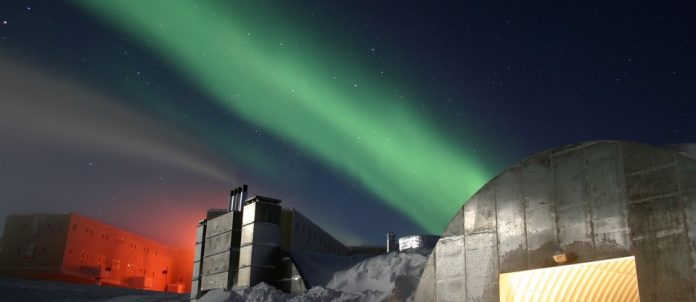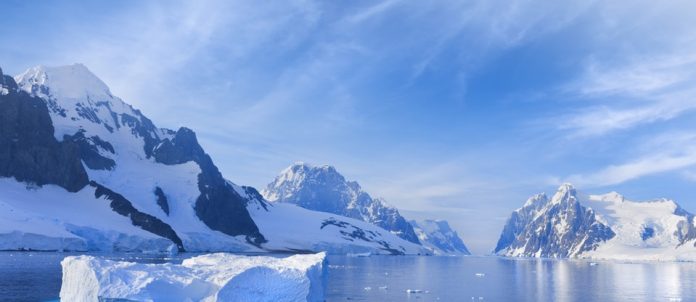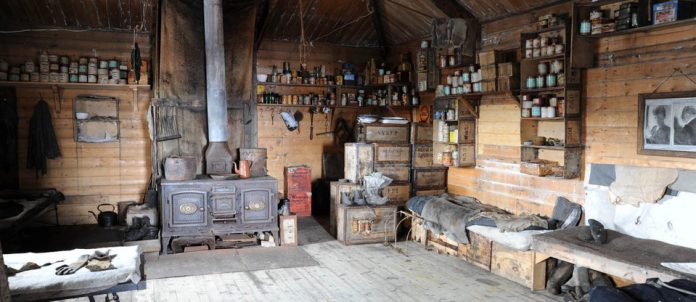No place on Earth compares to this vast white wilderness of elemental forces: snow, ice, water, rock. Antarctica is simply stunning.
Top experiences in Antarctica
The South Pole station
The South Pole station was built in phases, so the first group of occupants was able to take up residence in January 2003, and it was officially inaugurated in January 2008. Full summer operations began in October 2011. The 6039-sq-meter, elevated station stretches 128m, facing the prevailing winds with an aeronautical design that helps scour snow from beneath it. The complex accommodates 150 people in summer and 50 in winter.
Two separate, blue-gray, horseshoe-shaped modules are connected by flexible walkways and can be raised on stilts to prevent destructive snow buildup. The main entrance, sometimes called ‘Destination Alpha,’ faces the skiway. Another staircase entrance on the back of the station is ‘Destination Zulu.’
One module houses living quarters, a dining room, a bar, a hospital, a laundry, a store, a post office and a greenhouse (adding to the futuristic, space-station feeling of the new facility, the greenhouse is officially known as the ‘food-growth chamber’). In the other module are offices, labs, computers, telecommunications, an emergency-power plant, conference rooms, music practice rooms and a gym. Cozy reading rooms and libraries are scattered throughout both units.
Work on the Pole’s current US$174-million station began in 1997 and required 80 construction workers (25% of them women) to work nine-hour days, six days a week. In the 24-hour summer daylight, three crews worked shifts round the clock. Workers described how – among the unusual construction hazards here – metal burnt bare hands like a hot stove. The station’s normal winter population, meanwhile, nearly doubled with the extra staff devoted to construction. Hundreds of flights from McMurdo brought in the necessary building materials, which in turn had been planned, procured and shipped over many years to McMurdo.
Lemaire Channel
This steep-sided channel – just 1600m (5250ft) wide – runs for 11km (7 miles) between the mountains of Booth Island and the Peninsula. So photogenic that it’s been dubbed ‘Kodak Gap,’ the passageway is only visible once you’re nearly inside it. The channel was first navigated by the Belgian de Gerlache in 1898 and named after a Belgian explorer of the Congo.
Unfortunately, ice sometimes blocks the way, so ships may be forced to retreat and sail outside Booth Island. At the northern end of the Lemaire are two tall, rounded and often snowcapped peaks at Cape Renard.
Shackleton’s Hut
Shackleton erected this structure on his Nimrod expedition in February 1908. Fifteen men lived in the hut, which is much smaller than Scott’s at Cape Evans, and the feeling inside is still very atmospheric. All of Shackleton’s men left here alive (unlike at Scott’s hut), and apparently they left in a hurry: when members of the Terra Nova expedition visited in 1911, they found socks left hanging to dry and a meal still on the table.
Members of the Ross Sea party of Shackleton’s 1914–17 Enduranceexpedition also stopped by, commandeering tobacco and soap, among other treats.
Since these long-ago stopovers (snow filled it during one long interval between visits), the hut has undergone an extensive AHT conservation project (from 2004 to 2008). The weatherproofed result completely retains the hut’s historical appeal.
Eating
Visitors to Antarctica will eat aboard ship or at the bases run by their tour operators, and the price is included in the tour cost. The style and quality of food is usually well covered by tour operators in their promotional material, and if you have specific wishes or needs you should flag them up well in advance of departure, or even before booking your trip.
Drinking & Nightlife
Cruise ships usually have bar and drinking options, though the price of alcohol may not be included in the tour price (check in advance). Larger ships will have more options, though life aboard ship can be quite convivial, no matter the size.
Research stations can have raucous nightlife, with the 24-hour sunshine of summer or the extreme isolation of winter, but most tourists won’t gain access to the shore-side bars.
Entertainment
On-board lectures, films and events are the main form of entertainment aboard ship. They usually offer excellent background information for excursions and activities around the continent.



